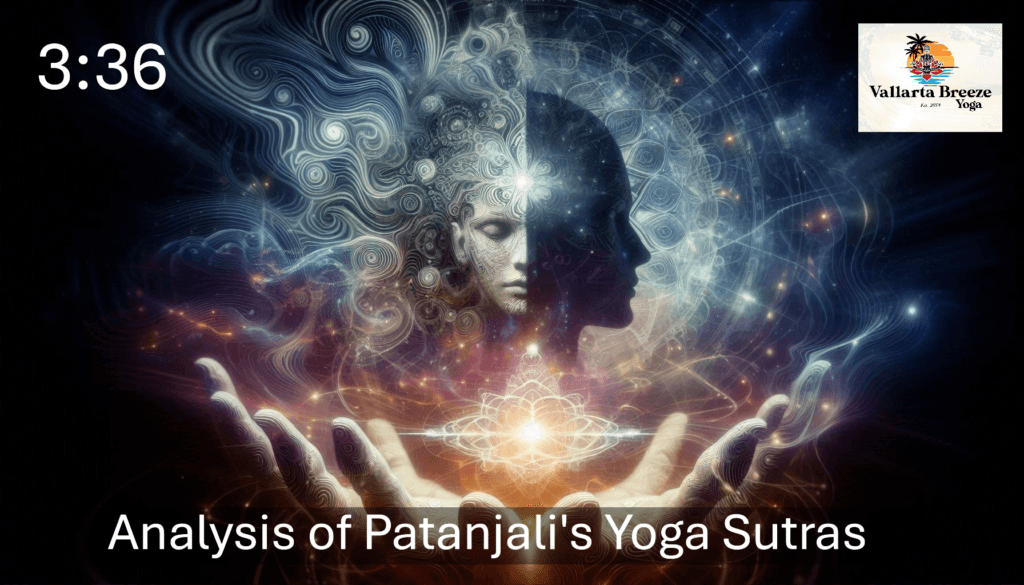Yoga Sutra 3.36 | Sattva-puruṣayor atyanta asaṃkīrṇayoḥ pratyayāviśeṣo bhogaḥ parārthatvātsvārthasaṃyamātpuruṣajñānam
Yoga Sutra 3.36 in Context
Sanskrit Text:
सत्त्वपुरुषयोरत्यन्तासंकीर्णयोः प्रत्ययाविशेषो भोगः परार्थत्वात्स्वार्थसंयमात्पुरुषज्ञानम्।
(Sattva-puruṣayor atyanta asaṃkīrṇayoḥ pratyayāviśeṣo bhogaḥ parārthatvātsvārthasaṃyamātpuruṣajñānam.)
Literal Translation:
“Enjoyment arises from the non-discrimination between the pure essence (sattva) and the Self (puruṣa), which are entirely distinct. By Samyama on the Self, knowledge of the puruṣa is gained.”
In Yoga Sutra 3.36, Patanjali explains how the inability to distinguish between sattva (the pure essence of the mind) and puruṣa (the eternal Self) leads to worldly experiences of pleasure and pain. Through focused meditation on the Self, the practitioner gains insight into the true nature of puruṣa, transcending the limitations of the mind and achieving spiritual clarity.
Historical and Cultural Significance
- The Distinction Between Sattva and Puruṣa:
Sattva represents the refined quality of the mind, characterized by clarity and harmony. However, it remains part of the material realm (prakṛti) and is distinct from puruṣa, the eternal consciousness. Ancient commentators like Vyasa describe the importance of recognizing this distinction to avoid confusion and attachment to transient experiences. - Knowledge of the Self (Puruṣa):
Meditation on the Self allows the practitioner to perceive the eternal nature of puruṣa, which exists beyond the fluctuations of the mind. This realization is described as a pivotal step in the journey toward liberation (moksha). - Universal Themes of Self-Realization:
The quest to understand the true Self is central to many spiritual traditions. For example, Vedanta emphasizes the distinction between Atman (individual self) and Brahman (universal consciousness), while Buddhist teachings focus on transcending the ego to achieve enlightenment.
Guidelines for Students
- Practicing Samyama on the Self:
Students are encouraged to meditate on the nature of puruṣa, focusing deeply on its eternal and unchanging qualities. This practice fosters clarity and detachment from the transient experiences of the mind. - Recognizing the Distinction Between Sattva and Puruṣa:
By observing the difference between the mind’s refined qualities (sattva) and the eternal Self (puruṣa), students can transcend mental distractions and align with their true nature. - Embracing the Journey of Self-Realization:
This sutra invites students to explore their inner world with humility and openness, using their insights to deepen their spiritual practice.
Insights and Strategies for Teachers
- Explaining the Nature of Sattva and Puruṣa:
Help students understand the distinction between the mind’s refined qualities and the eternal Self. Use relatable examples to illustrate how attachment to transient experiences can hinder spiritual growth. - Guiding Meditation on the Self:
Lead students in meditative practices focused on the eternal nature of puruṣa. Techniques such as silent reflection or self-inquiry can help deepen their understanding. - Inspiring the Pursuit of Liberation:
Share teachings that emphasize the importance of self-realization and detachment from the material world. Swami Sivananda beautifully remarked,
“Meditate on the Self, for it is the light that dispels the shadows of illusion.“
Philosophical and Practical Takeaways
- Yoga Sutra 3.36 emphasizes the importance of distinguishing between sattva and puruṣa to gain knowledge of the eternal Self. This practice nurtures self-awareness and facilitates spiritual growth.
- For students, this sutra provides a pathway to explore their connection with the eternal Self, cultivating clarity and detachment from transient experiences. For teachers, it highlights the importance of guiding students toward self-realization and liberation.
- As Swami Krishnananda stated, “Through meditation on the Self, the yogi perceives the eternal amidst the transient, discovering the essence of truth.“
Yoga Sutra 3.36 invites practitioners to deepen their understanding of the Self, using their insights to transcend the limitations of the mind and achieve spiritual clarity.
Continue your growth with the Vallarta Breeze Yoga Puerto Vallarta Yoga Studio!
Whether you’re looking to dive deeper into the physical practice of yoga, The Vedas, Upanishads, Yoga Sutras, or would like to explore our blog, we have a wealth of information available for you! Better yet, join us here in the Vallarta Breeze Yoga Puerto Vallarta Yoga studio, or practice with us online! we’re excited to continue this journey with you. See you on the mat!



